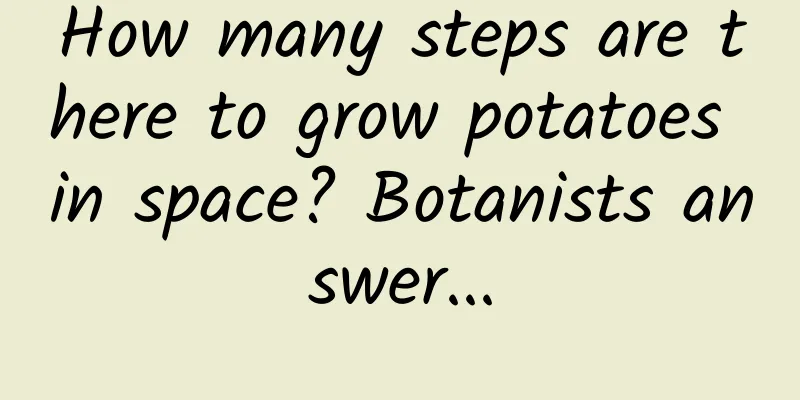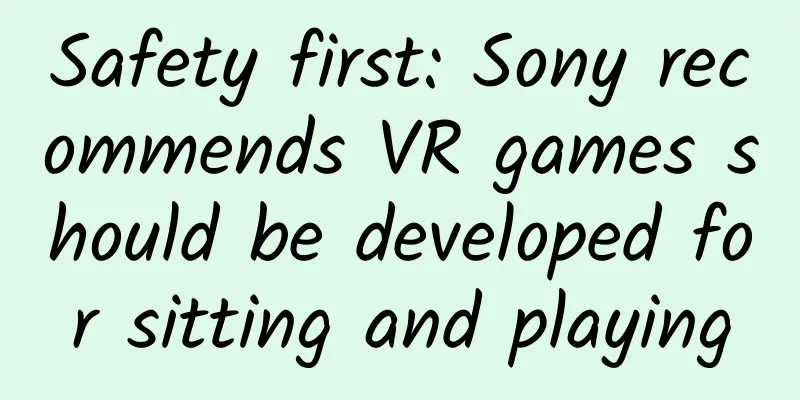How many steps are there to grow potatoes in space? Botanists answer...

|
On October 12, 2024, Shi Jun, a Ph.D. in botany and senior research librarian at the Chinese Academy of Sciences, gave a speech entitled "Moving the Vegetable Garden to Space" at the "Exploring the Galaxy and Pursuing Dreams in the Sky" theme session of the Science Popularization China Starry Sky Forum, telling us about plant science knowledge in space exploration. The following is an excerpt from Shi Jun’s speech: As the saying goes, "food is the primary need of the people." When traveling to the stars and the sea, there is one issue that cannot be avoided - food . Where does food come from in space? Some people say that we can bring it from Earth, but this is very expensive and cannot meet the needs of a large number of people. Therefore, we can only produce the food we need in space. So, of all the foods out there, why would we want to move our vegetable gardens to space? And why potatoes? There's actually a lot of interesting plant science to this. Why do we want to grow vegetables in space? First of all, the sun, the huge energy source that humans rely on, actually has a lifespan. So far, the sun's lifespan is about 4.6 billion years, which sounds long, but if the sun changes one day, we may need to move to another planet. In addition, we are also facing the threat of "extraterrestrial visitors", such as asteroids hitting the earth. Such impacts may cause large-scale extinction of organisms, which is not uncommon in the history of the earth. The most famous example is the one that caused the extinction of dinosaurs. Of course, these things sound far away from us, but humans are facing a more difficult problem today, which is global climate change. Due to the massive consumption of fossil fuels in the process of industrialization, the global climate is undergoing drastic changes, extreme weather events are becoming more frequent, and the earth may gradually become a place unsuitable for human habitation. In this case, we have to consider finding a new home, which is one of the reasons why we move our vegetable gardens to space. Growing potatoes in space, Why? How to plant? Why do we choose potatoes when growing vegetables in space? It's not just because potatoes are delicious, but also because of their own characteristics. The edible part of potatoes is not their flowers or fruits, but the tubers. Choosing to eat tubers brings significant advantages: just cut a potato into pieces and bury it in the soil to grow new potatoes. This method is simpler and more efficient than waiting for the potatoes to flower and fruit before harvesting the fruits. Potato field. Copyright image. Reproduction may cause copyright disputes. After bringing potatoes into space, where should they be planted? Everyone’s first reaction might be to plant them in the soil. However, this actually has many problems, because the soil on alien planets is different from the soil on Earth. Take Mars as an example. The soil on Mars contains complex ingredients that are difficult for us to imagine, especially perchlorates , which are mainly used for strong disinfection on Earth. For example, some disinfectant wipes contain perchlorates. Imagine that this disinfectant can kill all microorganisms. If potatoes are planted directly in this soil, the fate of the potatoes will probably be the same as those microorganisms and they will not be able to survive. Therefore, if we want to use Martian soil to grow potatoes, we must first thoroughly clean it to remove the perchlorates, and this process is very complicated. More importantly, there is no fertilizer in the Martian soil , and fertilizer is essential for plant growth. There is a Chinese agricultural proverb that "a flower in the crop depends on manure", which illustrates the importance of fertilizer to crop growth. Therefore, the first astronauts to land on Mars need to work hard to improve soil conditions. However, this does not mean that human excrement can be used directly as fertilizer, it must go through a fermentation process. Plants cannot absorb unfermented excrement, and only after it is fermented and decomposed into simple mineral nutrients can plants absorb and utilize it. Although this process sounds complicated, fortunately, we don't have to rely entirely on soil to grow plants. Many people may have tried hydroponics . As long as there is enough water, many vegetables, including potatoes, can be grown without soil. This new method of cultivation, instead of soaking potatoes directly in water, is suspended and nutrients are provided directly through spraying. This method has been quite mature. Therefore, we can still grow vegetables without soil. However, water is indispensable because it is an essential element for plant growth. Take the movie "The Martian" for example. In the movie, the protagonist planted a potato field of about 100 square meters on Mars. It takes 60 cubic meters, or 60 tons of water to grow these potatoes. Sounds scary, right? 60 tons of water is not a small amount. Not all of this water is used to grow potatoes. Some of it will be released into space by the potatoes. This is because when potatoes absorb nutrients, the fluid in their bodies needs to flow , just like the heart pumping blood. Although plants do not have a heart, they perform a similar function through their leaves. Each leaf is like a small water pump, and when water is released into the air, it generates a tiny force to pump up the water absorbed by the roots. Although this water pump is small, it consumes a lot of water. Therefore, it takes 60 cubic meters of water to grow more than 100 square meters of potatoes, which is a very large number. Fortunately, we now have various water-saving devices that can recycle water , which is already possible today. Therefore, water is no longer a major obstacle to growing vegetables in space. Imagined space farm (AIGC photo). Copyright image from the photo library. Reprinting and using it may cause copyright disputes. There is another obstacle to growing potatoes in space - light. Because the surface of Mars is bombarded with cosmic rays, high-energy particles, and strong ultraviolet rays, if we plant potatoes directly in the open air on the surface of Mars, the potatoes will quickly burn. So the problem we face is how to provide the plants with the right light. Fortunately, we have a variety of solutions. We can use solar cells and photovoltaic panels to convert sunlight into light that plants can use . In addition, we can greatly improve the efficiency of LED lights in providing light to plants. How do we do this? Most plants appear green because they only absorb certain wavelengths of light, mainly red and blue-violet light. They reflect green light, which is why we see plants appear green. Plants do not need green light, and today we can use LED lights to emit only red and blue-violet light , which fully meets the growth needs of plants. Therefore, it is entirely feasible to provide plants with suitable light in space gardens. There is another level that people may not usually imagine - lack of carbon dioxide. Some people may ask, will there still be a shortage of carbon dioxide? We discuss reducing carbon dioxide emissions every day, but the impact of carbon dioxide is two-sided. Although carbon dioxide has been somewhat demonized in many propaganda today, and people think it is a bad thing when the word carbon dioxide is mentioned, in fact, the positive impact of carbon dioxide on us is far greater than the negative impact. For example, carbon dioxide is a key component of the greenhouse effect. If the greenhouse effect disappears completely, then the surface of our earth is likely to become the same as the surface of the moon - the temperature difference between day and night may be several hundred degrees Celsius. Can life still survive on such a planet? Impossible. More importantly, in the space garden, we also need to provide plants with sufficient carbon dioxide. Why is this? We often talk about photosynthesis , which is the process by which green plants absorb carbon dioxide and water to produce glucose. This process is completed in two steps, one is the light reaction, and the other is the dark reaction. The so-called "light reaction" is the process of receiving sunlight, and the "dark reaction" is to convert the collected energy into energy stored in glucose. The picture comes from Shi Jun's speech PPT Then the problem comes. If there is not enough carbon dioxide, the "light reaction" of photosynthesis will continue, but the "dark reaction" will be blocked. The sunlight is still being collected continuously in front, and this energy will accumulate in the cells. It will also find some more active molecules to combine with them, such as combining with oxygen to form harmful free radicals. These free radicals can destroy proteins, DNA and cell structures, causing leaves to rot directly. In order to cope with this situation, plants may perform "photorespiration" to decompose the carbon dioxide they produce to maintain photosynthesis, but this is only a last resort. So, perhaps in the future space garden, carbon dioxide will become a valuable resource. There is a "hidden level" in growing potatoes in space - gravity. For people living on Earth, gravity is so common that we easily overlook its existence. But in space, everything is weightless, which is completely different from our environment on the ground. The plants we bring to space are also accustomed to the environment with gravity. For example, when we plant seeds in soil, the seedlings and buds of the plants will grow upwards, while the roots will grow downwards. This is exactly the effect of gravity. If there is no gravity, how do plants know which side is the sky and which side is the soil? How to solve this problem? The good news is that Chinese scientists found the key to solving this problem last year. They found that there are special particles in plant cells-amyloid. When these amyloids are affected by gravity, they will settle to the bottom of the cell. When these particles come into contact with the cell wall and cell membrane, they will transmit signals to tell the cell which side is down. Therefore, in the future we may use this discovery to help plants grow better in space. The picture comes from Shi Jun's speech PPT The preliminary attempts to "grow potatoes in space" are actually already underway. For example, our Tiangong space station has grown a variety of vegetables, especially lettuce. In the previous live broadcast, we have seen the astronauts in the Tiangong enjoying fresh lettuce. I don't know how they taste, but I hope everyone will have a chance to taste them in the future. Growing vegetables in space is not easy Growing vegetables on a spaceship is even more difficult! Growing vegetables in space is challenging, especially on a spacecraft. For example, in the 1990s, the United States conducted an experiment called Biosphere 2, which was intended to simulate a miniature Earth. The building was huge, with 180,000 cubic meters of space, divided into seven ecological zones, with 4,000 species placed in an attempt to simulate all ecosystems on Earth. The experiment lasted 21 months, but eventually had to be ended because the experimenters almost starved to death or suffocated because the small ecosystem could not function properly. The biggest revelation from this experiment is that the ecosystem on Earth is not formed simply by putting species together. The ecosystem is an organic whole and cannot be constructed simply by piling up species. Just like we cannot simply pile up car parts together and expect them to automatically assemble into a car. Therefore, even if we bring a large number of species together, they will not spontaneously form a healthy ecosystem. The best solution is still to protect our Earth, this beautiful blue planet. Even if one day we have the ability to go beyond the solar system, or even the Milky Way, to explore the more distant universe, we should not forget that the Earth will always be our home planet and our most beautiful home. This is something that each of us needs to keep in mind. I hope everyone will take this memory of the Earth with them to explore the sea of stars! Planning and production Author: Shi Jun, PhD in Botany, Chinese Academy of Sciences, Senior Research Librarian Editors: Zhang Yang, Yang Yaping Event Planning|Su Xuan Gansu Science and Technology Museum Publicity and Liaison Department Proofread by Xu Lai and Lin Lin |
>>: The invisible "gorilla": What does "selective attention" bring?
Recommend
I was drooling over the raw marinated seafood, and I was instantly hooked when I saw the parasites.
What outsiders consider dark cuisine is a feast f...
Every year, 650,000 people die from influenza worldwide, while tuberculosis kills 1.25 million!
In this issue, let’s talk about tuberculosis and ...
Analysis of basic energy consumption parameters of air conditioners: This is the most energy-saving way to operate them in summer!
It is already April, and people are gradually tak...
Is Miaopai's efforts in vertical content a desperate gamble or a confident move?
Vertical short videos are the first choice for sh...
Satellite cloud images help you understand the weather: What does a "front" look like? What is an "upward cloud top"?
Front Does the term “front” look very professiona...
6 ways to use countdown posters, how many have you seen?
Starting from July 21, Mr. Jia Yueting, Chairman ...
Discovered the magical solar system, not only has four gas giants, but also two asteroid belts
The planetary system around the star HR8799 is st...
Live streaming sales: Solve these 3 fatal problems first
Today, I suddenly felt like talking to you about ...
91 Ten Articles: Tesla raises prices in the US and China simultaneously, Wuling Hongguang will no longer be able to get a Shanghai license plate
1. Tesla Model 3 and Model Y have raised prices a...
OPPO Find7 User Experience
I have used the Fan 7 for 3 days. I want to write ...
Apple opens App Analytics to all developers for free
App Analytics, an app analysis tool provided by T...
China Association of Automobile Manufacturers: A brief analysis of the sales of key enterprise groups in the automobile industry from January to July 2023
According to statistics and analysis by the China...
Five elements and methods of operating Alibaba events!
I have worked in almost all types of operations a...
Large traditional automakers change their attitude: no longer mocking Tesla
Not long ago, large German automakers such as BMW...
Inference is completed in less than 1ms on iPhone 12, Apple proposes MobileOne, an efficient mobile backbone network
Efficient neural network backbones for mobile dev...









